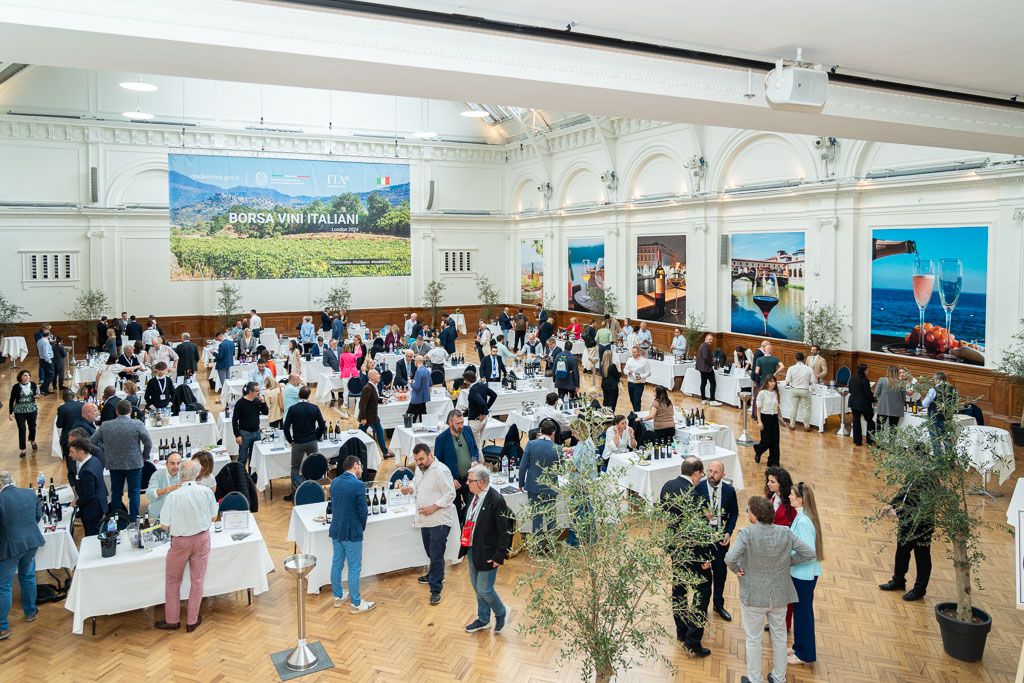As a well-established date in the trade’s tasting calendar, Borsa Vini Italiani (BVI) is invariably well-attended, and this year’s edition was no exception. Its organisers, the Italian Trade Agency, likes to rotate the venue to keep it fresh, and while this year’s choice was the solid but unspectacular Royal Horticultural Halls in Westminster, you could hardly say that about the wines on show and the setup that ITA designed. Over 200 were on show from 41 producers (all but two seeking UK distribution) in 13 key regions - namely Abruzzo, Apulia, Calabria, Campania, Friuli-Venezia Giulia, Lombardy, Marche, Piedmont, Tuscany, Sardinia, Sicily, Umbria and Veneto.
The length and breadth of Italy, therefore, and a wonderfully diverse selection of labels to lure the many buyers, sommeliers, off-trade representatives et alia who pitched up. “New business partnerships”, as ITA London director Giovanni Sacchi puts it, is what BVI is all about, and while one can only speculate about the extent of those, those who attended were able to delve into many of the scores of indigenous grape varieties Italy has - the most of any country with 377 registered varieties to its name, a long way ahead of France in second place on 204.*
Perhaps the more obscure varieties are the place to start, because two of the three masterclasses were ‘Family Estates: Unveiling lesser-known regions’ (by John Downes MW) and ‘Unknown Italy: white wines from the South’ (by Walter Speller, editor Italy for JancisRobinson.com). By way of contrast, the third was ‘International grapes in Italy’ (by Patrick Schmitt MW).
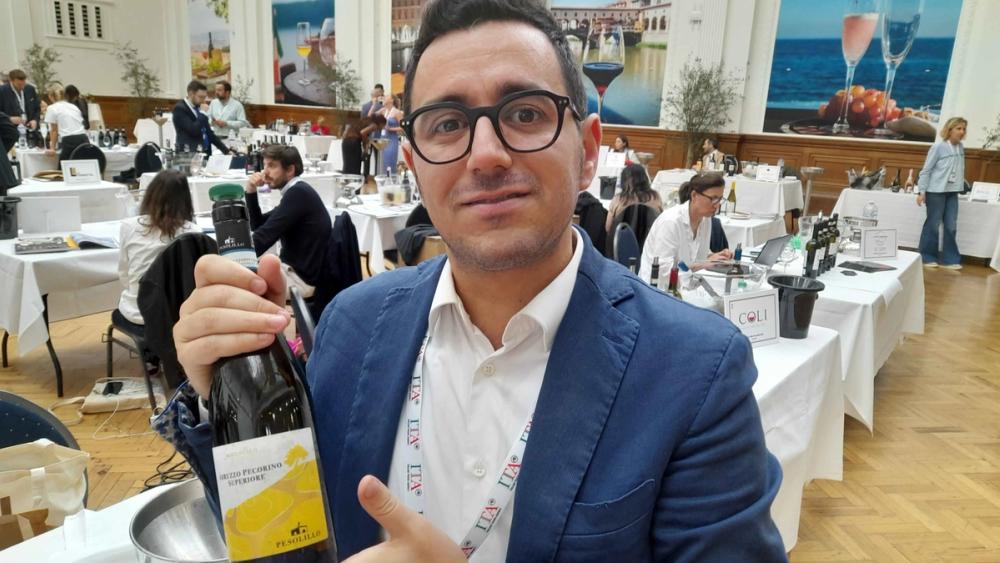
Lorenzo Pesolillo
Speller picked out a delightful Pecorino Superiore from the Pesolillo winery in Abruzzo DOC, whose joint owner Lorenzo Pesolillo I made a point of seeking out. This is precisely the sort of small family-owned set-up that BVI is designed to help when it comes to finding a UK importer.
Three brothers are involved - Lorenzo (exports), Luca (winemaker) and Marco (admin) - with father Giuseppe the viticulturist (his father having founded the winery in 1961). Organically-farmed vines at 200 metres close to the Adriatic Sea have produced a fresh wine with aromas of white flowers and notes of peach and pear, with hints of salinity and minerality. Annual production of around 50,000 bottles (also featuring Montepulciano and Passerina) was taken up entirely by the Italian market until two years ago when the family ventured into export markets that now include Canada, Mexico, Switzerland and Germany. “Now we like to get into the UK,” Lorenzo told me.
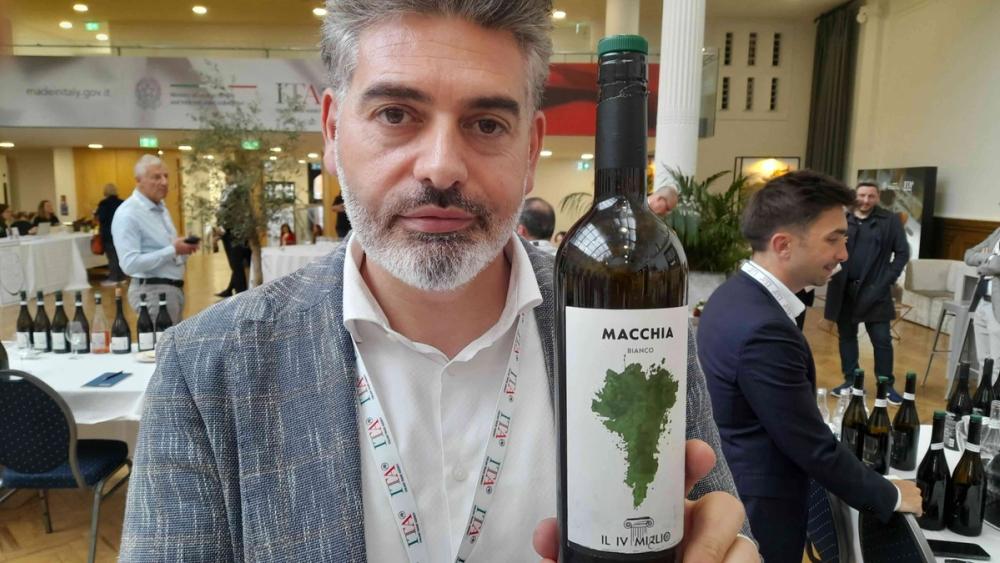
Ciro Verde
Across the other side of Italy, just outside Naples, and only 12km from Mount Vesuvius, can be found another impressive family-owned winery - that of Il Quarto Miglio (or ‘Fourth Mile’ as per the Roman unit of measurement). Winemaker Ciro Verde has the pleasure of crafting his wines from vines on their own roots, on what is ‘super volcanic’ soil, as he describes it. His appetising Macchia Blanco Falanghina Riserva 2018, made from Campania’s signature white grape, saw six hours of skin contact to provide weight, and has aged beautifully, retaining its freshness and stone fruit notes. His single varietal Piedirosso 2022, the second most planted black grape in Campania after Aglianico, also showed well, with its medium body, red fruit and soft tannins. Delitalia import the wines.
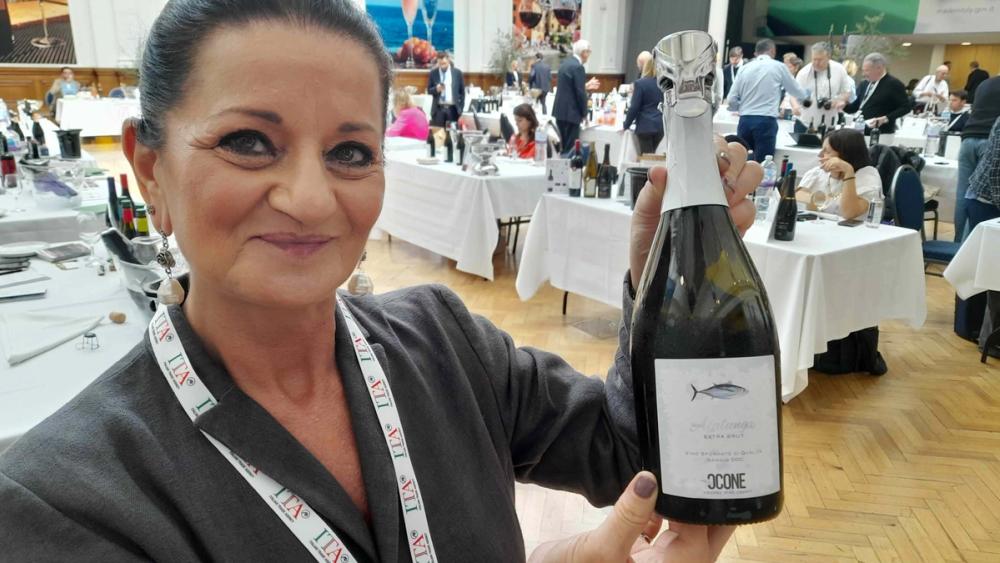
Antonietta Luongo of Ocone
Fellow Campania producer, Ocone, unfurled a very drinkable 12% abv sparkling Aglianico, named Alalunga Vino Spumante di Qualita Sannio 2021.
“We make 7,500 bottles of this by the Charmat method, but have a traditional method version with 36 months on the lees being released before Christmas,” export manager Antonietta Luongo said. “We export to North America, Asia, Europe and would like to add UK, where we were with Berkmann previously.”
Just over a third of the company’s annual production, which is around 180,000 bottles, is exported, with its premium Vigna del Monaco 2021 label another fine Falanghina from the sought-after Taburno sub-region, where their vines are planted up to 600 metres.

Michele & Andrea Bruno of Boccafolle di Balbia
Another of Speller’s shrewd selections was Boccafolle di Balbia in the Calabria town of Mottafollone. This intriguing little winery with five hectares under vine only deals in ancient indigenous varietals such as Greco Nero & Bianco, the black grape Magliocco and, rarest of all, Vujno. The latter, used in their Donna Elena white blend, was ‘completely unknown’ until last year when it was finally permitted as a varietal, according to Michele Bruno, whose family owns the winery. Pear and quince are its principal descriptors, which complement the herb and lemon notes of the other grape in the blend, Pecorino.
Bruno and his first cousin, Andrea, who happens to be one of Real Madrid’s lawyers, were at BVI in the hope of establishing a market in the UK. How had they done, I asked at the end of the tasting?
“We’ve made some good contacts with sommeliers, and some hotel chains and distributors are showing interest,” Michele declared. “We mostly export, with 80% going to the United States where I used to live.” The approachable Melara 2022 label (85% Magliocco from 65-year old vines) belied the varietal’s reputation for overt tannins, being only 12.5% abv.
Talking of lower alcohol wines, the Nebbiolo producer, Bosio Family Estates, attracted praise from Beans Boughton MW, buyer for Alliance Wine.
“These guys are into low alcohol,” Boughton mused, although none of their low abv labels were available for tasting. “I think their red wines are the best I’ve tasted at 11%, because they’re using innovative techniques to get there, using specific yeasts. From my perspective, their Barbaresco and Barolo are the sort of wines that could work for us, and maybe the Barbera, but we already have a lot of producers who do these, but not so many with such good value-to-price ratio as here.”
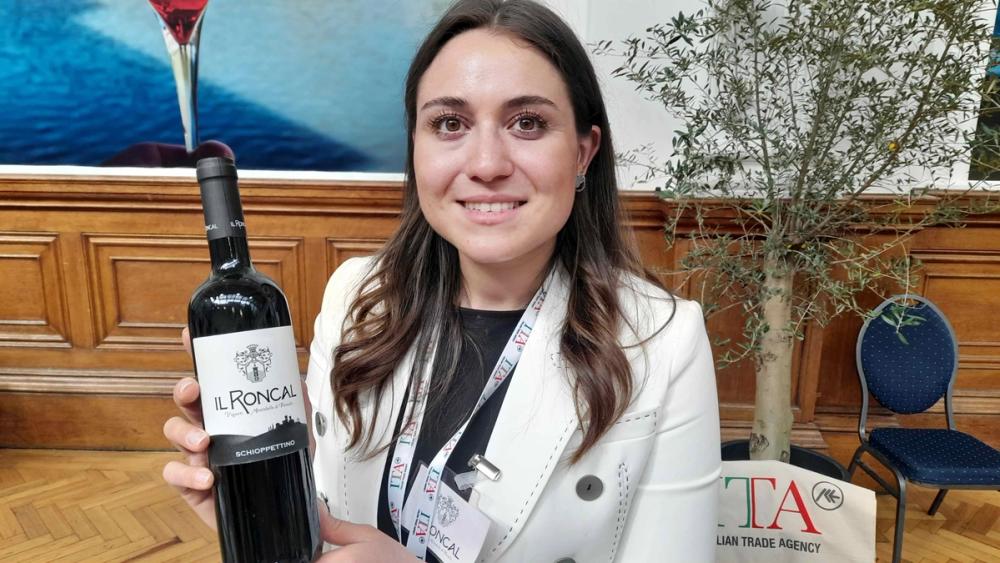
Angelica Zorzettig of Il Roncal
Also offering excellent value for money was Friuli winery, Il Roncal, which has 20 hectares of terraced vineyards on Colle Montebello, close to the UNESCO world heritage site town of Cividale del Friuli. Refreshing Ribolla Gialla, Pinot Grigio and Sauvignon Blanc labels were complemented by some enticing Schioppettino, the black grape indigenous to the region. Deeply-coloured yet medium-bodied, its violet-scented aromas gave way to black pepper and spicy notes on a long finish.

Barbara Ruppel of Castello del Trebbio
Another lesser-known red variety, Ciliejolo, whose spiritual home is Tuscany, made up a 50:50 split with Canaiolo in a very quaffable blend made by Chianti producer, Castello del Trebbio, which gained biodynamic certification last year.
“It’s an easy-drinking, mid-market IGT Toscana wine with a very nice balance between acidity and fruit that you can try chilled,” export manager Barbara Ruppel said. “Ellis of Richmond imports our other two brands in Maremma and Sardinia, but we are looking for distribution here.” Ciliejolo means ‘cherry’ in Italian, notes of which were apparent.
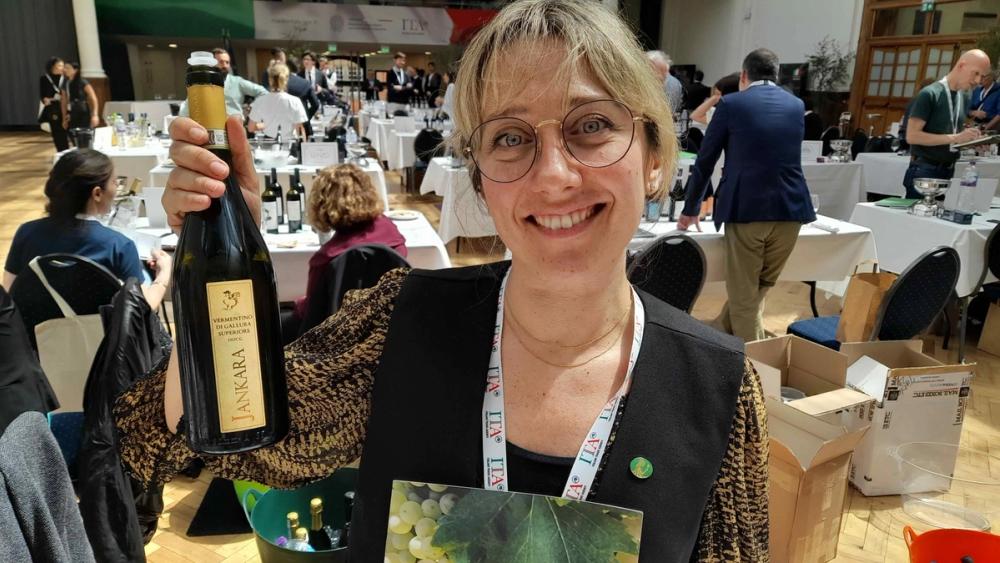
Bernadetta Battistini of Empson
Reverting to mainstream varieties, Empson & Co, a leading exporter of fine Italian wines worldwide, is looking for UK distribution for two of their brands: Toscolo in Chianti and Jankara in Sardinia. The latter’s Vermentino di Gallura Superiore DOCG 2023 showed particularly well, with Empson’s export manager, Bernadetta Battistini, extolling its virtues.
“It is very good Vermentino,which retails in Italy for between €30-35,” she said. “It benefits from granitic soils and very fresh winds from the sea.” She revealed the muscular Jankara Cannonau di Sardegna DOC 2020, produced from vines at 700 metres and compared stylistically by Schmitt in his masterclass to Châteauneuf-du-Pape, had impressed Ed Fairfax of importer Waud Wines.
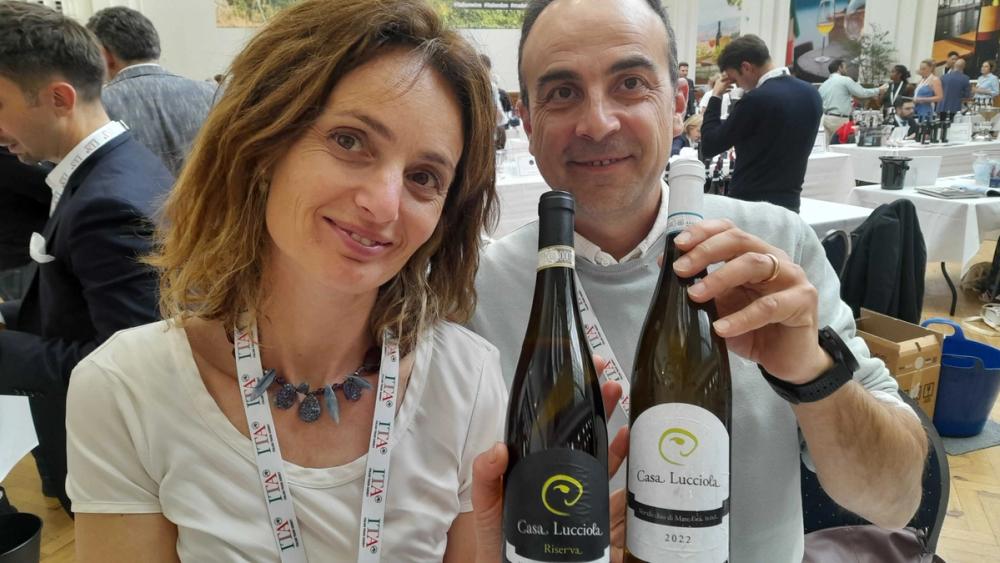
Barbara & Luca Cruciani of Casa Lucciola
Talking of Italian white varietals, one small winery that makes nothing but Verdicchio caught the eye - Casa Lucciola in the Marche region, longtime home of the grape. Owner-winemaker Luca Cruciani farms four hectares organically at 430m on clay and limestone soils in the Matelica Valley.
“He lost his mind 25 years ago and planted vines,” wife Barbara joked. The couple produce five Verdicchio labels with some very appealing fruit and notable freshness (RRP in Italy €13-21).” It is the grape of our territory and does very well in our terroir, with a continental climate.” Luca said. “We select the best grapes to produce approximately 12,000 bottles.”
By contrast, Muratori produces up to 500,000 bottles per annum of Franciacorta from 50 hectares, which is available through Boutique Brands.
“It’s been selling well here, and is an emerging category, so very exciting,” Tommy Harrigan, one of the importer’s buyers, said. “Muratori has vines in each of the six areas of Franciacorta, so gets all different soil types. The Brut NV is the most popular style we have - very user-friendly.” Three other labels were on view, including an excellent zero dosage 100% Chardonnay.
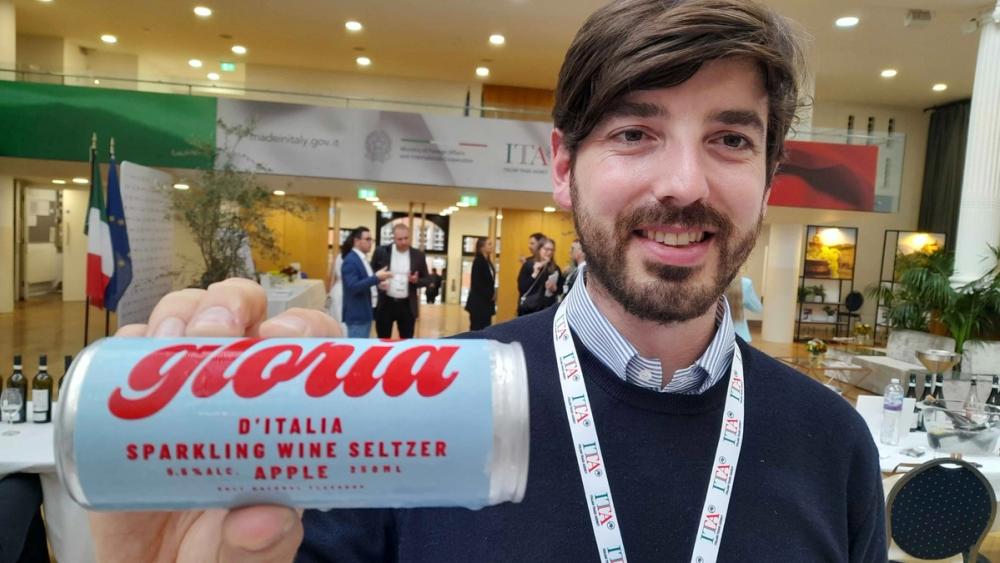
Sebastian Vismara of Gloria
Finally, a quirky SKU to end with. A company named Gloria d’Italia, founded by Sebastian Vismara, is producing 25cl cans of carbonated spritzer made up of 55% Pinot Grigio (Trentino fruit), 35% water and 10% apple juice (5.5% abv). Vibrant acidity balances residual sugar of 12g/l.
“It’s been on the market for six months now - just in Australia where my co-founder Pierro lives and where it’s done well in bottle shops, pubs, hotels and cocktail bars,” Vismara said. “There is a huge trend for ready-to-drink products, and we’re looking for distribution in the US and UK. We’re aiming to sell 30,000 cans this year [RRP AU$8, or £4], and have done half that already, and can increase production to half a million a year . Sale price to distributors is £1.”
* (source: the ‘Wine Grapes’ bible by the prophets Harding, Robinson and Vouillamoz).

